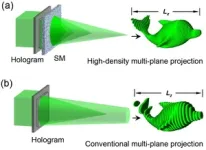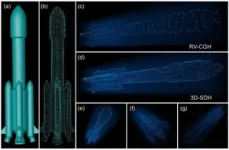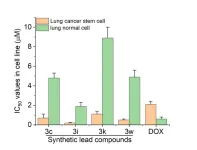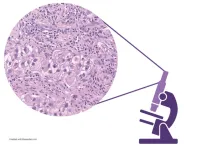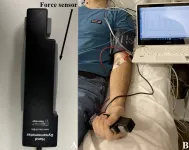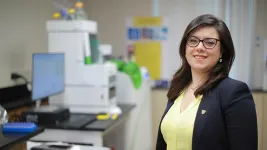(Press-News.org) WASHINGTON — Researchers have developed a new way to create dynamic ultrahigh-density 3D holographic projections. By packing more details into a 3D image, this type of hologram could enable realistic representations of the world around us for use in virtual reality and other applications.
“A 3D hologram can present real 3D scenes with continuous and fine features,” said Lei Gong, who led a research team from the University of Science and Technology of China. “For virtual reality, our method could be used with headset-based holographic displays to greatly improve the viewing angles, which would enhance the 3D viewing experience. It could also provide better 3D visuals without requiring a headset.”
Producing a realistic-looking holographic display of 3D objects requires projecting images with a high pixel resolution onto a large number of successive planes, or layers, that are spaced closely together. This achieves high depth resolution, which is important for providing the depth cues that make the hologram look three dimensional.
In Optica, Optica Publishing Group’s journal for high-impact research, Gong’s team and Chengwei Qiu’s research team at the National University of Singapore describe their new approach, called three-dimensional scattering-assisted dynamic holography (3D-SDH). They show that it can achieve a depth resolution more than three orders of magnitude greater than state-of-the-art methods for multiplane holographic projection.
“Our new method overcomes two long-existing bottlenecks in current digital holographic techniques — low axial resolution and high interplane crosstalk — that prevent fine depth control of the hologram and thus limit the quality of the 3D display,” said Gong. “Our approach could also improve holography-based optical encryption by allowing more data to be encrypted in the hologram.”
Producing more detailed holograms
Creating a dynamic holographic projection typically involves using a spatial light modulator (SLM) to modulate the intensity and/or phase of a light beam. However, today’s holograms are limited in terms of quality because current SLM technology allows only a few low-resolution images to be projected onto sperate planes with low depth resolution.
To overcome this problem, the researchers combined an SLM with a diffuser that enables multiple image planes to be separated by a much smaller amount without being constrained by the properties of the SLM. By also suppressing crosstalk between the planes and exploiting scattering of light and wavefront shaping, this setup enables ultrahigh-density 3D holographic projection.
To test the new method, the researchers first used simulations to show that it could produce 3D reconstructions with a much smaller depth interval between each plane. For example, they were able to project a 3D rocket model with 125 successive image planes at a depth interval of 0.96 mm in a single 1000×1000-pixel hologram, compared to 32 image planes with a depth interval of 3.75 mm using another recently developed approach known as random vector-based computer-generated holography.
To validate the concept experimentally, they built a prototype 3D-SDH projector to create dynamic 3D projections and compared this to a conventional state-of- the-art setup for 3D Fresnel computer-generated holography. They showed that 3D-SDH achieved an improvement in axial resolution of more than three orders of magnitude over the conventional counterpart.
The 3D holograms the researchers demonstrated are all point-cloud 3D images, meaning they cannot present the solid body of a 3D object. Ultimately, the researchers would like to be able to project a collection of 3D objects with a hologram, which would require a higher pixel-count hologram and new algorithms.
Paper: P. Yu, Y. Liu, Z. Wang, J. Liang, X. S. Liu, Y. Li, C. Qiu, L. Gong, “Ultrahigh-density 3D Holographic Projection by Scattering-assisted Dynamic Holography,” 10, 4 (2023).
DOI: 10.1364/OPTICA.483057.
About Optica
Optica is an open-access journal dedicated to the rapid dissemination of high-impact peer-reviewed research across the entire spectrum of optics and photonics. Published monthly by Optica Publishing Group, the Journal provides a forum for pioneering research to be swiftly accessed by the international community, whether that research is theoretical or experimental, fundamental or applied. Optica maintains a distinguished editorial board of more than 60 associate editors from around the world and is overseen by Editor-in-Chief Prem Kumar, Northwestern University, USA. For more information, visit Optica.
About Optica Publishing Group (formerly OSA)
Optica Publishing Group is a division of Optica, the society advancing optics and photonics worldwide. It publishes the largest collection of peer-reviewed content in optics and photonics, including 18 prestigious journals, the society’s flagship member magazine, and papers from more than 835 conferences, including 6,500+ associated videos. With over 400,000 journal articles, conference papers and videos to search, discover and access, Optica Publishing Group represents the full range of research in the field from around the globe.
END
Technology advance paves way to more realistic 3D holograms for virtual reality and more
Researchers overcome two bottlenecks in current digital holographic techniques
2023-04-06
ELSE PRESS RELEASES FROM THIS DATE:
Novel tridimensional anticancer agents developed to fight against drug-resistant cancer cells
2023-04-06
A research team co-led by chemists from City University of Hong Kong (CityU) recently discovered novel, highly effective anticancer agents with tridimensional structures, which have high anticancer activity, low toxicity and the ability to overcome drug resistance in cancer cells. The findings help provide a new direction for anticancer drug development.
Cancer has long been a devastating disease, which affects millions of people worldwide. Despite advances in treatment, current anticancer drugs often have limited effectiveness, lack of cancer ...
ASBMB urges NIAID to prioritize DEAI
2023-04-06
The American Society for Biochemistry and Molecular Biology sent recommendations March 30 to the National Institute of Allergy and Infectious Diseases on expanding the institute’s diversity, equity, accessibility and inclusivity activities.
The society recommended, broadly, that the NIAID expand the use of diversity and re-entry grant supplements and better support disabled, LGBTQ+ and other underrepresented scientists.
“Because NIAID is one of the largest NIH institutes, they have ...
How to make better consistency and availability trade-offs in networks
2023-04-06
Imagine you want to withdraw some cash from an ATM. You expect it to show your account balance correctly and process your request quickly. However, network delays make it hard for the system to meet both of these simple expectations at the same time. If an ATM system tries to achieve high “consistency,” meaning that it displays the latest account balance by checking a remote database, it could make you wait or even prevent you from accessing your accounts during busy times. On the other hand, if an ATM system favors “availability,” it could let you access your accounts fast, but risk showing inaccurate information. To avoid undesired results, ...
Science journals integrate Dryad to simplify data deposition and strengthen scientific reproducibility
2023-04-06
The Science family journals have announced a partnership with the nonprofit data repository Dryad that simplifies the process by which authors deposit data underlying new work – a critical step to facilitating data’s routine reuse. The partnership is yet another step taken by the Science journals to ensure data the scientific community requires to verify, replicate and reanalyze new research is openly available.
“Addressing public access to data at scale is a critical challenge,” said Holden Thorp, Editor-in-Chief of the Science family ...
Men and women have different obesity drivers, pointing to the need for tailored interventions
2023-04-06
A new study from UCLA researchers finds sex-specific brain signals that appear to confirm that different drivers lead men and women to develop obesity. The study, appearing in the peer-reviewed journal Brain Communications, combined data from several modes of MRI with patients’ clinical features and personal histories to identify sex-specific mechanisms in the brain underlying obesity.
“We found differences in several of the brain’s networks associated with early life adversity, mental ...
Disparities identified among patients receiving advanced pulmonary support
2023-04-06
Some adults with severe respiratory illness, including women, those with public insurance, and people with fewer financial resources, may be less likely to receive an advanced form of life support known as extracorporeal membrane oxygenation (ECMO). A research team supported by the National Institutes of Health found that adults who received ECMO appeared to skew toward men, people with private health insurance, and those who came from areas with higher median incomes. ECMO helps patients with life-threatening illness or injury breathe by simulating the function of the heart and/or lungs, while giving those organs a chance to rest.
The study published in the Annals of the American ...
Researchers ID biomarkers of response to immunotherapy for kidney cancer
2023-04-06
The number of immune cells in and around kidney tumors, the amount of dead cancer tissue, and mutations to a tumor suppressor gene called PBRM1 form a biomarker signature that can predict — before treatment begins — how well patients with kidney cancer will respond to immunotherapy, according to new research directed by investigators at the Johns Hopkins Kimmel Cancer Center and its Bloomberg~Kimmel Institute for Cancer Immunotherapy.
In reviews of 136 kidney tumor biopsies taken for previous studies, investigators found that patients who had three positive factors — presence of immune cells in and around tumors, known as tumor-infiltrating immune cells, absence ...
Studying consciousness without affecting it
2023-04-06
Studies of consciousness often run into a common conundrum of science—it’s hard to measure a system without the measurement affecting the system. Researchers assessing consciousness, for instance as volunteers receive anesthesia, typically use spoken commands to see if subjects can still respond, but that sound might keep them awake longer or wake them up sooner than normal. A new study not only validates a way to assess consciousness without external stimulation, it also finds that it may be more precise.
“We want to measure when people make the transition from conscious to unconscious, and vice versa, but as soon as you ask someone to do something, which is the classic ...
New pesticide exposure test developed to protect inexperienced cannabis farmers
2023-04-06
A chemical analyst and expert in micro-extraction at The University of Toledo created a more reliable, robust and efficient way to monitor pesticide exposure and help protect the health and safety of agricultural workers, especially for emerging sectors like the cannabis industry.
Dr. Emanuela Gionfriddo, an assistant professor of analytical chemistry, and Nipunika H. Godage, a Ph.D. candidate in UToledo’s Dr. Nina McClelland Laboratory for Water Chemistry and Environmental Analysis, published research in the journal Analytical and Bioanalytical Chemistry outlining their groundbreaking method that is able to detect 79 pesticide residues in human blood plasma ...
Binghamton University receives $9.3 million in federal funding to train school-based mental health professionals
2023-04-06
BINGHAMTON, N.Y. -- Economically disadvantaged students face food scarcity, unreliable access to services and other stressors, which can have a huge impact on their mental health. In Broome and Tioga counties, more than 50% of children live in families characterized as low income. New federal funding will help to put more Binghamton University social work students in schools to provide the services that these students need to succeed.
The U.S. Department of Education has awarded two 5-year awards, totalling $9.3 million, to Binghamton University Community Schools (BUCS) to ...
LAST 30 PRESS RELEASES:
Scientists use ultrasound to soften and treat cancer tumors without damaging healthy tissue
Community swimming program for Black youth boosts skills, sense of belonging, study finds
Specific depressive symptoms in midlife linked to increased dementia risk
An ‘illuminating’ design sheds light on cholesterol
Who is more likely to get long COVID?
Study showcases resilience and rapid growth of “living rocks”
Naval Research Lab diver earns Office of Naval Research 2025 Sailor of the Year
New Mayo-led study establishes practical definition for rapidly progressive dementia
Fossil fuel industry’s “climate false solutions” reinforce its power and aggravate environmental injustice
Researchers reveal bias in a widely used measure of algorithm performance
Alcohol causes cancer. A study from IOCB Prague confirms damage to DNA and shows how cells defend against it
Hidden viruses in wastewater treatment may shape public health risks, study finds
Unlock the power of nature: how biomass can transform climate mitigation
Biochar reshapes hidden soil microbes that capture carbon dioxide in farmland
Reducing saturated fat intake shows mortality benefit, but only in high-risk individuals
Manta rays create mobile ecosystems, study finds
Study: Mixed results in using lipoic acid to treat progressive multiple sclerosis
Norbert Holtkamp appointed director of Fermi National Accelerator Laboratory
New agentic AI platform accelerates advanced optics design
Biologists discover neurons use physical signals — not electricity — to stabilize communication
Researchers discover that a hormone can access the brain by hitchhiking
University of Oklahoma researcher awarded funding to pursue AI-powered material design
Exploring how the visual system recovers following injury
Support for parents with infants at pediatric check-ups leads to better reading and math skills in elementary school
Kids’ behavioral health is a growing share of family health costs
Day & night: Cancer disrupts the brain’s natural rhythm
COVID-19 vaccination significantly reduces risk to pregnant women and baby
The role of vaccination in maternal and perinatal outcomes associated with COVID-19 in pregnancy
Mayo Clinic smartwatch system helps parents shorten and defuse children's severe tantrums early
Behavioral health spending spikes to 40% of all children’s health expenditures, nearly doubling in a decade
[Press-News.org] Technology advance paves way to more realistic 3D holograms for virtual reality and moreResearchers overcome two bottlenecks in current digital holographic techniques

